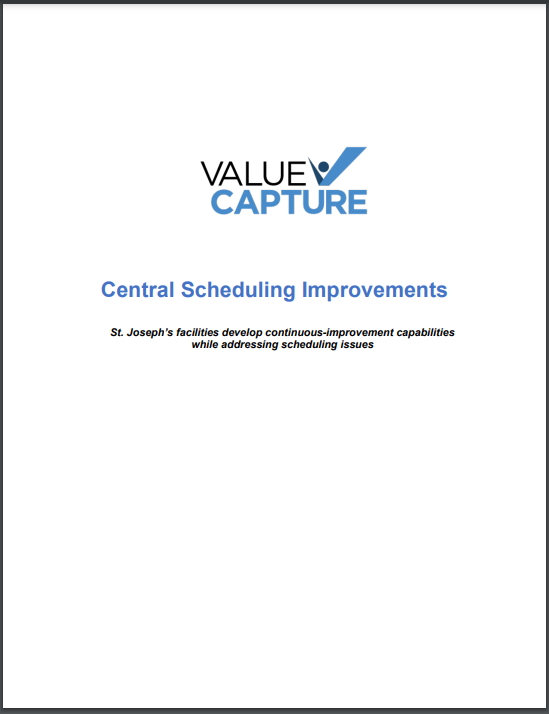
Download now using the form:
By registering to receive this white paper, you will also receive occasional email newsletters and other email communications from Value Capture. You can unsubscribe at any time.
Download the St. Joseph's White Paper
Central Scheduling Improvements
Introduction
The Central Scheduling department works with leaders to ensure that appropriate levels of staffing exist throughout clinical and non-clinical departments and profoundly impacts how a healthcare organization delivers quality care. Only when central scheduling processes falter and affect how, when, and where staff are deployed do they usually garner attention.
The central scheduling processes at two facilities in the St. Joseph’s Health System (SJHS) — St. Joseph’s Lifecare Centre Brantford (SJLCB) and St. Joseph’s Health Centre Guelph (SJHCG) in Ontario, Canada — were fraught with challenges that negatively impacted employees, patients, residents, and clients, especially when staffing shortages were compounded by the COVID-19 pandemic.
Leaders and staff at the two facilities knew their scheduling processes needed to be improved. The thought of improving the processes was particularly welcomed by the leaders who were working tirelessly to staff their departments and the Central Scheduling staff who felt overburdened by the workload. Despite the challenges in the central scheduling processes, the culture within both organizations enabled most to realize that the scheduling problems were not due to the people involved but were a result of the lack of standardized scheduling processes with clear accountability. The unsystematic processes (amplified by the COVID pandemic) resulted in:
- Defects (e.g., unstaffed shifts, staff double-booked, individuals called into work at the last minute)
- Delays that impacted staff (e.g., employees unsure of shifts because schedules were posted late) and departments (e.g., the Payroll department at the Brantford location regularly worked overtime to reconcile scheduling records and close the books)
- Ongoing rework of schedules that began immediately after posting
- Challenges for staff when requesting and getting time off and unsure that the schedule addressed their needs
- Tension, frustration, and dissatisfaction among staff affected staff retention and relationships
- Staff working short or, alternatively, staff working significant amounts of overtime.
“Our processes were creating a lot of dissatisfaction, and we never really got to the root cause of what was happening and why it was happening. We knew we needed to do something, so it was ‘Let’s pause for a moment, bring a cross-functional team together to take a deep look at what is going on, and then use what we learn to determine how we should proceed toward improvement that will have a positive impact.’”
White Paper Sections:
- Scheduling Objectives
- Understanding the Scheduling Process
- Ideal- and Future-State Scheduling Process
- Implementation and Outcomes
